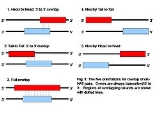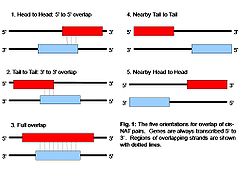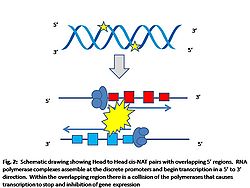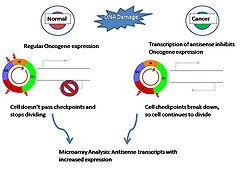
Cis-natural antisense transcript
Encyclopedia
Natural antisense transcripts (NATs) are a group of RNA
s encoded within a cell that have transcript complementarity to other RNA transcripts. They have been identified in multiple eukaryotes, including humans, mice, yeast and Arabidopsis thaliana. This class of RNAs includes both protein-coding and non-coding RNAs. Current evidence has suggested a variety of regulatory roles for NATs, such as RNA interference
(RNAi), alternative splicing
, genomic imprinting, and X-chromosome inactivation
. NATs are broadly grouped into two categories based on whether they act in cis or in trans. Trans-NATs are transcribed from a different location than their targets and usually have complementarity to multiple transcripts with some mismatches. MicroRNAs (miRNA) are an example of trans-NATs that can target multiple transcripts with a few mismatches. Cis-natural antisense transcripts (cis-NATs) on the other hand are transcribed from the same genomic locus as their target but from the opposite DNA strand and form perfect pairs.
 Cis-NATs have a variety of orientations and differing lengths of overlap between pairs. There have been five identified orientations for cis-NATs to date. The most common orientation is head-to-head, where the 5' ends of both transcripts align together. This orientation would result in the greatest knockdown of gene expression if transcriptional collision is the reason for transcript inhibition. There is however some studies that have suggested that tail-to-tail orientations are the most common NAT pairs. Others such as tail to tail, overlapping, nearby head-to- head, and nearby tail-to-tail are less frequently encountered. Completely overlapping NATs involve the antisense gene being located completely over top of each other . Nearby head-to-head and tail-to-tail orientations are physically discrete from each other but are located very close to each other. Current evidence suggests that there is an overrepresentation of NAT pairs in genes that have catalytic activity. There may be something about these genes in particular that makes them more prone to this type of regulation.
Cis-NATs have a variety of orientations and differing lengths of overlap between pairs. There have been five identified orientations for cis-NATs to date. The most common orientation is head-to-head, where the 5' ends of both transcripts align together. This orientation would result in the greatest knockdown of gene expression if transcriptional collision is the reason for transcript inhibition. There is however some studies that have suggested that tail-to-tail orientations are the most common NAT pairs. Others such as tail to tail, overlapping, nearby head-to- head, and nearby tail-to-tail are less frequently encountered. Completely overlapping NATs involve the antisense gene being located completely over top of each other . Nearby head-to-head and tail-to-tail orientations are physically discrete from each other but are located very close to each other. Current evidence suggests that there is an overrepresentation of NAT pairs in genes that have catalytic activity. There may be something about these genes in particular that makes them more prone to this type of regulation.
methods for detecting NATs suffer from several shortcomings depending on the source of sequence information. Studies that use mRNA have sequences whose orientations are known, but the amount of mRNA sequence information available is small . Predicted gene models using algorithms trained to look for genes gives an increased coverage of the genome at the cost of confidence in the identified gene. Another resource is the extensive expressed sequence tag
(EST) libraries but these small sequences must first be assigned an orientation before useful information can be extracted from them . Some studies have utilized special sequence information in the ESTs such as the poly(A) signal, poly(A) tail, and splicing sites to both filter the ESTs and to give them the correct transcriptional orientation. Combinations of the different sequence sources attempts to maximize coverage as well as maintain integrity in the data.
Pairs of NATs are identified when they form overlapping clusters. There is variability in the cut-off values used in different studies but generally ~20 nucleotides of sequence overlap is considered the minimum for transcripts to be considered and overlapping cluster. Also, transcripts must map to only one other mRNA molecule in order for it to be considered a NAT pair. Currently there are a variety of web and software resources that can be used to look for antisense pairs. The NATsdb or Natural Antisense Transcript database is a rich tool for searching for antisense pairs from multiple organisms.
 Molecular mechanisms behind the regulatory role of cis-NATs are not currently well understood. Three models have been proposed to explain the regulatory effects that cis-NATs have on gene expression. The first model attributes that base pairing between the cis-NAT and its complementary transcript result in a knockdown of mRNA expression. The assumption of this model is that there will be a precise alignment of at least 6 base pairs between the cis-NAT pair to make double stranded RNA. Epigenetic modifications like DNA methylation
Molecular mechanisms behind the regulatory role of cis-NATs are not currently well understood. Three models have been proposed to explain the regulatory effects that cis-NATs have on gene expression. The first model attributes that base pairing between the cis-NAT and its complementary transcript result in a knockdown of mRNA expression. The assumption of this model is that there will be a precise alignment of at least 6 base pairs between the cis-NAT pair to make double stranded RNA. Epigenetic modifications like DNA methylation
and post-translational modification of core histone
s form the basis of the second model. Although it is not yet clearly understood, it is thought that the reverse transcript guides methylation complexes and/or histone-modifying complexes to the promoter regions of the sense transcript and cause an inhibition of expression from the gene. Currently it is not known what attributes of cis-NATs are crucial for the epigenetic model of regulation. The final proposed model that has gained favour due to recent experimental evidence is the transcriptional collision model. During the process of transcription of cis-NATs, the transcriptional complexes assemble in the promoter regions of the gene. RNA polymerase
s will then begin transcribing the gene at the transcription initiation site laying down nucleotides in a 5' to 3' direction. In the areas of overlap between the cis-NATs the RNA polymerases will collide and stop at the crash site. Transcription is inhibited because RNA polymerases prematurely stop and their incomplete transcripts get degraded.
. A flurry of interest in gene regulatory networks has been sparked by the advent of sequenced genomes of multiple organisms. The next step is to use this information to figure out how genes work together and not just in isolation. During the processes of mammalian development, there is an inactivation of the extra X-chromosome in females. It has been shown that a NAT pair called Xist and Tsix are involved in the hypermethylation of the chromosome. As much as 20-30% of mammalian genes have been shown to be the targets of miRNA
s, which highlights the importance of these molecules as regulators across a wide number of genes. Evolutionary reasons for utilizing RNA for regulation of genes may be that it is less costly and faster than synthesizing proteins not needed by the cell. This could have had a selective advantage for early eukaryotes with this type of transcriptional regulation.
 Antisense transcription might contribute to disease through chromosomal changes that result in the production of aberrant antisense transcripts. A documented case of cis-NATs being involved in human disease comes from an inherited form of α-thalassemia
Antisense transcription might contribute to disease through chromosomal changes that result in the production of aberrant antisense transcripts. A documented case of cis-NATs being involved in human disease comes from an inherited form of α-thalassemia
where there is silencing of the hemoglobin
α-2 gene through the action of a cis-NAT. It is thought that in malignant cancer cells with activated transposable elements creates a large amount of transcriptional noise. It is likely that aberrant antisense RNA transcripts resulting from this transcriptional noise may cause stochastic methylation of CpG island
s associated with oncogene
s and tumor suppressor gene
s. This inhibition would further progress the malignancy of the cells since they lose key regulator genes. By looking at upregulated antisense transcripts in tumor cells, researchers and look for more candidate tumor suppressor genes. Also, aberrant cis-NATs have been implicated in neurological diseases such as Parkinson's disease
.
RNA
Ribonucleic acid , or RNA, is one of the three major macromolecules that are essential for all known forms of life....
s encoded within a cell that have transcript complementarity to other RNA transcripts. They have been identified in multiple eukaryotes, including humans, mice, yeast and Arabidopsis thaliana. This class of RNAs includes both protein-coding and non-coding RNAs. Current evidence has suggested a variety of regulatory roles for NATs, such as RNA interference
RNA interference
RNA interference is a process within living cells that moderates the activity of their genes. Historically, it was known by other names, including co-suppression, post transcriptional gene silencing , and quelling. Only after these apparently unrelated processes were fully understood did it become...
(RNAi), alternative splicing
Alternative splicing
Alternative splicing is a process by which the exons of the RNA produced by transcription of a gene are reconnected in multiple ways during RNA splicing...
, genomic imprinting, and X-chromosome inactivation
X-inactivation
X-inactivation is a process by which one of the two copies of the X chromosome present in female mammals is inactivated. The inactive X chromosome is silenced by packaging into transcriptionally inactive heterochromatin...
. NATs are broadly grouped into two categories based on whether they act in cis or in trans. Trans-NATs are transcribed from a different location than their targets and usually have complementarity to multiple transcripts with some mismatches. MicroRNAs (miRNA) are an example of trans-NATs that can target multiple transcripts with a few mismatches. Cis-natural antisense transcripts (cis-NATs) on the other hand are transcribed from the same genomic locus as their target but from the opposite DNA strand and form perfect pairs.
Orientation of cis-NATs

Identification approach
Identification of NATs in whole genomes is possible due to the large collection of sequence data available from multiple organisms. In silicoIn silico
In silico is an expression used to mean "performed on computer or via computer simulation." The phrase was coined in 1989 as an analogy to the Latin phrases in vivo and in vitro which are commonly used in biology and refer to experiments done in living organisms and outside of living organisms,...
methods for detecting NATs suffer from several shortcomings depending on the source of sequence information. Studies that use mRNA have sequences whose orientations are known, but the amount of mRNA sequence information available is small . Predicted gene models using algorithms trained to look for genes gives an increased coverage of the genome at the cost of confidence in the identified gene. Another resource is the extensive expressed sequence tag
Expressed sequence tag
An expressed sequence tag or EST is a short sub-sequence of a cDNA sequence. They may be used to identify gene transcripts, and are instrumental in gene discovery and gene sequence determination. The identification of ESTs has proceeded rapidly, with approximately 65.9 million ESTs now available in...
(EST) libraries but these small sequences must first be assigned an orientation before useful information can be extracted from them . Some studies have utilized special sequence information in the ESTs such as the poly(A) signal, poly(A) tail, and splicing sites to both filter the ESTs and to give them the correct transcriptional orientation. Combinations of the different sequence sources attempts to maximize coverage as well as maintain integrity in the data.
Pairs of NATs are identified when they form overlapping clusters. There is variability in the cut-off values used in different studies but generally ~20 nucleotides of sequence overlap is considered the minimum for transcripts to be considered and overlapping cluster. Also, transcripts must map to only one other mRNA molecule in order for it to be considered a NAT pair. Currently there are a variety of web and software resources that can be used to look for antisense pairs. The NATsdb or Natural Antisense Transcript database is a rich tool for searching for antisense pairs from multiple organisms.
Mechanisms

DNA methylation
DNA methylation is a biochemical process that is important for normal development in higher organisms. It involves the addition of a methyl group to the 5 position of the cytosine pyrimidine ring or the number 6 nitrogen of the adenine purine ring...
and post-translational modification of core histone
Histone
In biology, histones are highly alkaline proteins found in eukaryotic cell nuclei that package and order the DNA into structural units called nucleosomes. They are the chief protein components of chromatin, acting as spools around which DNA winds, and play a role in gene regulation...
s form the basis of the second model. Although it is not yet clearly understood, it is thought that the reverse transcript guides methylation complexes and/or histone-modifying complexes to the promoter regions of the sense transcript and cause an inhibition of expression from the gene. Currently it is not known what attributes of cis-NATs are crucial for the epigenetic model of regulation. The final proposed model that has gained favour due to recent experimental evidence is the transcriptional collision model. During the process of transcription of cis-NATs, the transcriptional complexes assemble in the promoter regions of the gene. RNA polymerase
RNA polymerase
RNA polymerase is an enzyme that produces RNA. In cells, RNAP is needed for constructing RNA chains from DNA genes as templates, a process called transcription. RNA polymerase enzymes are essential to life and are found in all organisms and many viruses...
s will then begin transcribing the gene at the transcription initiation site laying down nucleotides in a 5' to 3' direction. In the areas of overlap between the cis-NATs the RNA polymerases will collide and stop at the crash site. Transcription is inhibited because RNA polymerases prematurely stop and their incomplete transcripts get degraded.
Importance
Regulation of many biological processes such as development, metabolism and many others requires a careful co-ordination between many different genes; this is usually referred to as a gene regulatory networkGene regulatory network
A gene regulatory network or genetic regulatory network is a collection of DNA segments in a cell whichinteract with each other indirectly and with other substances in the cell, thereby governing the rates at which genes in the network are transcribed into mRNA.In general, each mRNA molecule goes...
. A flurry of interest in gene regulatory networks has been sparked by the advent of sequenced genomes of multiple organisms. The next step is to use this information to figure out how genes work together and not just in isolation. During the processes of mammalian development, there is an inactivation of the extra X-chromosome in females. It has been shown that a NAT pair called Xist and Tsix are involved in the hypermethylation of the chromosome. As much as 20-30% of mammalian genes have been shown to be the targets of miRNA
Mirna
Mirna may refer to:geographical entities* Mirna , a river in Istria, Croatia* Mirna , a river in Slovenia, tributary of the river Sava* Mirna , a settlement in the municipality of Mirna in Southeastern Sloveniapeople...
s, which highlights the importance of these molecules as regulators across a wide number of genes. Evolutionary reasons for utilizing RNA for regulation of genes may be that it is less costly and faster than synthesizing proteins not needed by the cell. This could have had a selective advantage for early eukaryotes with this type of transcriptional regulation.
Cis-NATs and disease

Thalassemia
Thalassemia is an inherited autosomal recessive blood disease that originated in the Mediterranean region. In thalassemia the genetic defect, which could be either mutation or deletion, results in reduced rate of synthesis or no synthesis of one of the globin chains that make up hemoglobin...
where there is silencing of the hemoglobin
Hemoglobin
Hemoglobin is the iron-containing oxygen-transport metalloprotein in the red blood cells of all vertebrates, with the exception of the fish family Channichthyidae, as well as the tissues of some invertebrates...
α-2 gene through the action of a cis-NAT. It is thought that in malignant cancer cells with activated transposable elements creates a large amount of transcriptional noise. It is likely that aberrant antisense RNA transcripts resulting from this transcriptional noise may cause stochastic methylation of CpG island
CpG island
In genetics, CpG islands or CG islands are genomic regions that contain a high frequency of CpG sites but to date objective definitions for CpG islands are limited. In mammalian genomes, CpG islands are typically 300-3,000 base pairs in length. They are in and near approximately 40% of promoters of...
s associated with oncogene
Oncogene
An oncogene is a gene that has the potential to cause cancer. In tumor cells, they are often mutated or expressed at high levels.An oncogene is a gene found in the chromosomes of tumor cells whose activation is associated with the initial and continuing conversion of normal cells into cancer...
s and tumor suppressor gene
Tumor suppressor gene
A tumor suppressor gene, or anti-oncogene, is a gene that protects a cell from one step on the path to cancer. When this gene is mutated to cause a loss or reduction in its function, the cell can progress to cancer, usually in combination with other genetic changes.-Two-hit hypothesis:Unlike...
s. This inhibition would further progress the malignancy of the cells since they lose key regulator genes. By looking at upregulated antisense transcripts in tumor cells, researchers and look for more candidate tumor suppressor genes. Also, aberrant cis-NATs have been implicated in neurological diseases such as Parkinson's disease
Parkinson's disease
Parkinson's disease is a degenerative disorder of the central nervous system...
.

